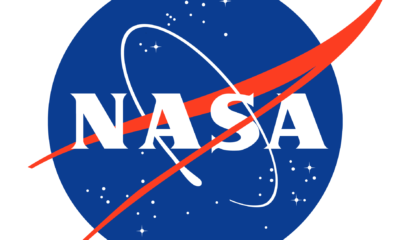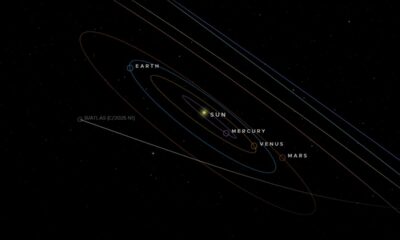Science
NASA Reports Surge in Solar Activity: A New Era Begins

NASA has announced a significant increase in solar activity, marking a surprising shift after years of decline. This change, observed over the past 16 years, may have considerable implications for space weather and technology on Earth. The findings were published in the peer-reviewed Astrophysical Journal Letters earlier this month by NASA scientists Jamie Jasinski and Marco Velli.
The research indicates that solar activity began to rise again after 2008, reversing a decades-long trend that had suggested a prolonged period of low activity. “All signs were pointing to the Sun going into a prolonged phase of low activity,” said Jasinski, a space plasma physicist at NASA’s Jet Propulsion Laboratory. “So it was a surprise to see that trend reversed. The Sun is slowly waking up.”
This uptick in solar activity could lead to more frequent solar storms, solar flares, and coronal mass ejections, as the researchers noted. Such space weather phenomena can affect spacecraft operations and pose risks to astronauts. Moreover, the effects may extend to Earth, impacting power grids, GPS systems, and radio communications, according to NASA.
The downward trend in solar activity, which lasted from the 1980s until 2008, saw the Sun reach its weakest point on record. NASA’s data indicates that solar activity typically fluctuates in 11-year cycles, with longer patterns observed as well. Currently, Earth is experiencing Solar Cycle 25, which began in 2020 and was noted as the weakest solar cycle in a century by the National Weather Service.
Scientists initially believed that the Sun would remain in what they termed a “deep solar minimum,” anticipating a continuation of its quiet phase. However, Jasinski’s study highlighted a reversal in this trend, tracking increasing bursts of solar plasma and stronger magnetic field measurements throughout the solar system.
Looking ahead, Solar Cycle 26 is expected to commence sometime between January 2029 and December 2032, according to the National Oceanic and Atmospheric Administration. The agency has yet to provide specific predictions for this upcoming cycle.
To enhance monitoring of space weather, NASA is set to launch the Interstellar Mapping and Acceleration Probe (IMAP) and Carruthers Geocorona Observatory missions, along with NOAA’s SWFO-L1 mission aboard the Falcon 9 rocket as early as next week. This initiative follows the successful launch of TRACERS twin satellites, which study how solar wind interacts with Earth’s magnetic field.
“Space weather predictions are critical for supporting the spacecraft and astronauts of NASA’s Artemis campaign, as understanding the space environment is a vital part of mitigating astronaut exposure to space radiation,” NASA stated recently.
In May 2024, NASA recorded the strongest geomagnetic storm in over two decades, triggered by several X-class solar flares. These events caused the northern lights to be visible at unusually low latitudes, reaching as far south as Mexico.
The ramifications of geomagnetic storms can be extensive, affecting technology on a large scale. “Internet service providers could go down, which in turn would take out the ability of different systems to communicate with each other,” electrical engineer David Wallace noted in a previous report. High-frequency communication systems, such as ground-to-air and ship-to-shore radios, could also experience disruptions.
As solar activity continues to rise, the implications for both space exploration and terrestrial technology are becoming increasingly evident. NASA’s ongoing research and upcoming missions will be crucial in understanding and managing these changes.
-

 Technology5 months ago
Technology5 months agoDiscover the Top 10 Calorie Counting Apps of 2025
-

 Technology3 weeks ago
Technology3 weeks agoOpenAI to Implement Age Verification for ChatGPT by December 2025
-

 Health3 months ago
Health3 months agoBella Hadid Shares Health Update After Treatment for Lyme Disease
-

 Health3 months ago
Health3 months agoAnalysts Project Stronger Growth for Apple’s iPhone 17 Lineup
-

 Health3 months ago
Health3 months agoErin Bates Shares Recovery Update Following Sepsis Complications
-

 Technology5 months ago
Technology5 months agoDiscover How to Reverse Image Search Using ChatGPT Effortlessly
-

 Technology3 months ago
Technology3 months agoElectric Moto Influencer Surronster Arrested in Tijuana
-

 Technology2 months ago
Technology2 months agoDiscover 2025’s Top GPUs for Exceptional 4K Gaming Performance
-

 Technology5 months ago
Technology5 months agoMeta Initiates $60B AI Data Center Expansion, Starting in Ohio
-

 Technology5 months ago
Technology5 months agoRecovering a Suspended TikTok Account: A Step-by-Step Guide
-

 Health5 months ago
Health5 months agoTested: Rab Firewall Mountain Jacket Survives Harsh Conditions
-

 Lifestyle5 months ago
Lifestyle5 months agoBelton Family Reunites After Daughter Survives Hill Country Floods



















